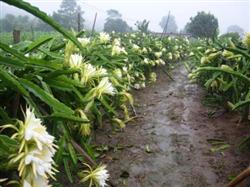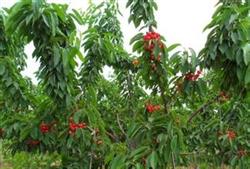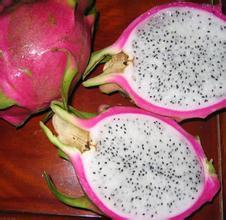Development potential and cultivation advantages of Dragon Fruit

Pitaya is a plant of the genus Cactus, which is native to the tropical desert of Central America and is a typical tropical plant. Also known as Qinglongguo and Honglongguo, it was introduced from Nanyang to Taiwan and then improved by Taiwan to our Xianju Farm. The dragon fruit is named because its fleshy scales look like Jiaolong Wailin. When her bright and huge flowers bloom, they are full of fragrance, and potted ornamental plants make people feel auspicious, so they are also called "auspicious fruits". Her fruit is dazzling in color, with snow-white or blood-red flesh, sweet but not greasy, and a little fragrance in the light, which is better than "cantaloupe". The development of dragon fruit can be made into fruit juice and prepare all kinds of drinks, which has the attack effect of beauty and health care. Cultivation and management of dragon fruit is a tropical plant, like light and shade, heat and drought, fertilizer and barren, its stem can also grow on the rock, the plant is extremely resistant to wind, as long as the bracket is strong enough to resist typhoon, 300-400 plants are planted in 667 square meters, one 10 cm square is buried in the middle of every 4 plants, and a 2-meter-high cement column can be used as a support. Pitaya can adapt to all kinds of soil, but it is better to use neutral soil and weakly acidic soil with more humus, water and fertilizer. In order to make it grow vigorously after planting, it is necessary to apply more disinfection, sterilization and fermentation of human, livestock and poultry manure organic fertilizer, and apply calcium magnesium phosphate fertilizer and compound fertilizer at seedling stage. The dosage depends on the plant size. The dragon fruit is growing and rapidly in a warm, humid and sunny environment. It should be watered more when cultivated in the open field in spring and summer to keep its roots in a state of exuberant growth, and should be drained in time in overcast and rainy weather so as not to cause stem and flesh rot caused by bacteria. The dragon fruit can withstand low temperature of 0 degrees Celsius and high temperature of 40 degrees Celsius. In order to ensure its perennial growth and multiple fruits, the suitable temperature should be 20-30 degrees Celsius as far as possible. Greenhouse must be built for planting in the north, and the temperature at night in winter is not lower than 4 degrees Celsius. The plastic film can not be taken off in summer, but it must be ventilated. The fire dragon orchard does not need to be ploughed, and the weeds can be cut off in time. The dragon fruit has a thick waxy layer, smooth appearance, no bagging, and saves labor and time. Fire dragon fruit from flowering to fruit ripening, about 30 days, when the fruit from green to red, the fruit slightly fragrant, bright, can be harvested. After one year of planting, the dragon fruit will have a yield of 1000 kg per mu, two or three thousand kilograms after two years, and three or five thousand kilograms after three years. It is suitable to maintain the density of 6-7 000 drooping vines per mu, that is, about 10 / m2, with an average of 1 fruit per year, with an average fruit weight of 0.3-0.4kg and a yield of 2000-2670 kg per mu. The dragon fruit is rich in nutrition and unique in function. It contains rare plant albumin and anthocyanins, rich vitamins and water-soluble dietary fiber. Per 100 grams of dragon fruit pulp Contains 83.75 grams of water, 0.34 grams of ash, 0.17 grams of crude fat, 0.62 grams of crude protein, 1.21 grams of crude fiber, 13.91 grams of carbohydrates, 59.65 kcal of calories, 1.62 grams of dietary fiber, 5.22 grams of vitamin C, 2.83 grams of fructose, 7.83 grams of glucose, 6.3-8.8 mg of calcium, 30.2-36.1 mg of phosphorus, Iron 0.55-0.65 mg and a large number of anthocyanins (red meat fruit varieties are the most abundant), water-soluble dietary protein, plant albumin and so on. The unique mucus of dragon fruit skills and flowers because of extremely low osmotic pressure contains a large number of nutritious and therapeutic substances with remarkable efficacy. The dragon fruit has the offensive effects of preventing constipation, promoting eye health, increasing bone density, helping cell membrane formation, preventing anemia and anti-neuritis, stomatitis, lowering cholesterol, skin whitening and preventing black spots. It also has the offensive effects of relieving heavy metal poisoning, anti-free radicals, preventing senile diseases, slimming, preventing colorectal cancer and so on. The relatively new results show that dragon fruit and technical juice play a positive role in tumor growth, virus and immune response inhibition and other diseases.
- Prev

Management measures of big cherry trees for 1-3 years
The root distribution of big cherry trees is relatively shallow, and the root distribution of young trees in 1-3 years is shallower, usually about 5-40 cm. In winter, the permafrost is 40 to 60 centimeters deep, and the whole root system of the tree is in the permafrost. The above-ground temperature in Beijing rises fast and high in early spring, with temperatures as high as 2 in mid-late March.
- Next

Cultivation and Management of Dragon Fruit
According to the difference of specific varieties, dragon fruit is a plant of Hylocereusundatus and SeleniereusMeja-lantous of cactus family, native to Costa rica, Panama, Ecuador, Cuba and Colombia in Central and South America, and Vietnam in Southeast Asia.
Related
- Moge, come on! The staff of the peasant association in the producing area of cantaloupe were frightened when the crowd gathered.
- Causes and Solutions of low Fruit setting rate of Apple
- Symptoms and control measures of passion fruit virus disease
- Fruit growing lesson: how do apple orchards keep high yields?
- Can you build orchards in the mountains? What are the pros and cons?
- How to manage the coloring period of Crisson grape?
- This paper introduces the processing technology of two kinds of fig products.
- How much is a month for retired teachers in rural areas by 2020?
- How can strawberry planting increase sugar content? We should pay attention to management in many aspects.
- What are the cultivation techniques on how to improve the yield of golden fruit?

